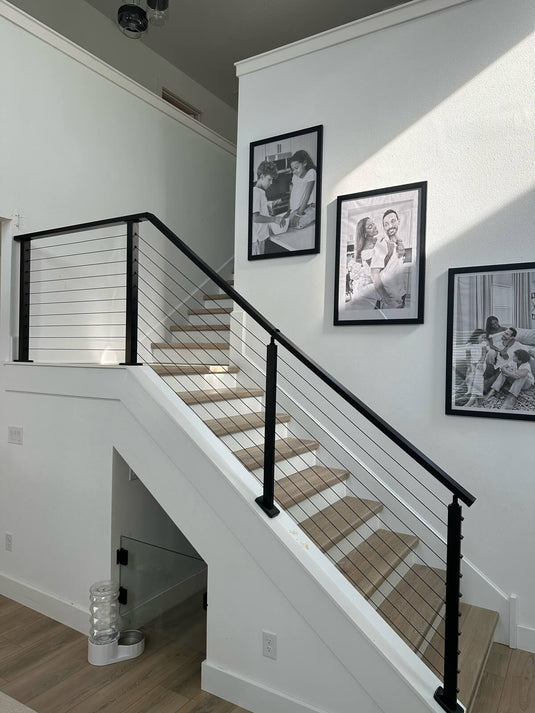TABLE OF CONTENTS
Muzata Commercial Deck Railing Height: IBC-Compliant Solution
In modern commercial architecture, sleek and secure railing systems are essential—not just for safety and compliance, but also for aesthetics and functionality. Cable railings have become a top choice for office terraces, hotel balconies, and rooftop bars, offering unobstructed views, minimal maintenance, and a contemporary look that elevates any space. But even the most stylish railing must prioritize safety—and that starts with getting the height right. A railing that's too low can lead to costly violations, legal liabilities, and even tragic accidents. Whether you're designing a high-rise terrace or a ground-level deck, understanding code-compliant railing height is non-negotiable.

Photo credit: Muzata customer
💡This blog will explore why Muzata stainless steel cable railings are a go-to solution for commercial deck railing projects—and how to ensure yours meets (or exceeds) U.S. safety standards. Let's get started!
Understanding Deck Railing Height Codes for Commercial Buildings
📋IBC Deck Railing Height Requirements
The International Building Code (IBC) sets the standard for deck railing height in commercial settings:
● Minimum height: 42 inches (measured from the deck surface to the top of the rail)
● Guardrail openings: Must prevent a 4-inch sphere from passing through (to prevent child entrapment)
These regulations apply to decks, balconies, and elevated walkways 30 inches or higher above ground level.
🔑Why the Height of Deck Railing Matters
Ensuring Stability & Accessibility
Properly designed railings act as a sturdy support system, helping children, elderly individuals, and those with mobility limitations move confidently on stairs, decks, and elevated walkways.
Reducing Fall Risks
Regulations on railing height, spacing, and structural integrity are not arbitrary—they exist to minimize dangerous falls in homes, commercial buildings, and public spaces.
Safeguarding Vulnerable Users
Codes mandate features like closely spaced balusters and minimum height requirements to prevent children from climbing or slipping through gaps, while also assisting seniors in maintaining balance.

Photo credit: Rebecca Brand / Muzata customer
📋Local Variations & Exceptions
While the International Building Code sets baseline standards, local jurisdictions often modify requirements based on regional risks. Key variations include:
● Height Adjustments: Some cities (e.g., Chicago) mandate 42+ inches for railings in high-wind zones.
● Material Rules: Coastal areas (e.g., California) may require corrosion-resistant materials like T304 stainless steel.
● Seismic Upgrades: Earthquake-prone regions (e.g., Seattle) enforce stricter structural anchoring.
● Historic Buildings: Exceptions may apply for aesthetics, but safety retrofits are often required.
Always verify with local building departments—what's compliant in one state could fail inspection in another.
🔑Why Commercial Deck Railing Height Matters
Safety & Legal Compliance
The International Building Code (IBC) mandates a minimum 42-inch height for commercial deck railings (vs. 36 inches for residential). This prevents falls in high-traffic areas like restaurants, hotels, and office terraces. Key considerations:
● Baluster spacing: ≤4 inches to prevent child entrapment.
● Load capacity: Railings must withstand 200+ lbs of force.
● Regional variations: Always check state/local amendments (e.g., California's stricter seismic requirements).
Liability Reduction
Non-compliance risks fines, lawsuits, and insurance issues. For architects and contractors, specifying code-compliant railings like Muzata pre-engineered stainless steel systems mitigates liability.

Photo credit: Muzata customer
☂️Safety & Durability: Preparing for Outdoor Conditions
Commercial decks face heavy use and weather exposure, especially during rainy spring seasons. Choosing the right materials ensures longevity and safety.
Weather-Resistant Materials
Stainless steel cable railings resist rust, corrosion, warping from moisture and UV damage. Powder-coated aluminum is also a durable option.
Structural Integrity
● Posts should be securely anchored to withstand wind and weight loads.
● Muzata cable tensioning systems prevent sagging over time.

Photo credit: Muzata customer
Designing with Muzata Stainless Steel Cable Railings
Why Muzata Stainless Steel Cable Railings Are the Best Choice for Commercial Decks
1. Unmatched Safety & Compliance
Unlike wood or wrought iron, Muzata stainless steel cable railings:
● Don't rot, warp, or weaken over time
● Maintain consistent spacing (no sagging)
● Pass rigorous safety inspections

Photo credit: Steve Amarilo / Muzata customer
2. Built for Durability in Rainy Spring Weather
Spring brings heavy rain, humidity, and temperature swings. Muzata T304 stainless steel resists:
🌧 Rust & corrosion (unlike powder-coated alternatives)
☀ UV damage (won't fade or degrade)
❄ Freeze-thaw cycles (ideal for all climates)

3. Low Maintenance & Long-Term Cost Savings
● Easy cleaning with mild soap & water
● Longer lifespan (outlasts wood & aluminum)
4.Modern & Sleek Style
✔ Sleek, minimalist aesthetics (ideal for high-end properties)
✔ Unobstructed views: Thin stainless steel cables preserve sightlines (great for rooftop bars, hotels, and office decks)

Muzata Commercial Deck Railing Height: Meets What the Codes Require
IBC & OSHA Standards for Deck Rail Height
The International Building Code (IBC) and Occupational Safety and Health Administration (OSHA) set strict guidelines for commercial deck railings:
| Requirement | Details |
| Minimum Height | 42 inches (from deck surface to top rail |
| Maximum Opening Size | 4-inch sphere cannot pass through (prevents child entrapment) |
| Load Capacity | 200 lbs. of force applied at any point (ensures structural integrity) |
How Muzata Stainless Steel Cable Railings Meet Code
Muzata commercial cable railing systems are engineered for full compliance:
✔ 42-inch height standard (adjustable for local codes)
✔ Cable spacing under 4 inches (prevents climbing & falls)
✔ High-strength T304 stainless steel (exceeds load requirements)

| Manufacturer | Muzata |
| Material | T304 Stainless stell |
| Post height | 42'' (Post Body 41'') |
| Cable spacing | 3'' (Level holes) |
| Norm |
|
Conclusion

Choosing the right deck rail height is non-negotiable for commercial projects. Navigating commercial deck railing height codes and material selection doesn't have to be daunting. By adhering to 42-inch IBC standards, selecting weather-resistant materials, and leveraging modern designs like stainless steel cable railings, architects and contractors can deliver safe, stylish, and low-maintenance solutions that stand up to 2025's demands. For high-quality commercial-grade cable railing systems, explore Muzata Railing's solutions—engineered for safety, durability, and style. Muzata cable railings are definitely the ideal solution for code-compliant, low-maintenance commercial decks.
📌 Ready to Spec? Explore our commercial railing kits or request a custom quote!
FAQ
Q: What is the code for deck railing height?
A: U.S. deck railing height codes require 42" (107cm) for commercial/multi-family decks (per IBC) and 36" (91cm) for residential (per IRC), with ≤4" baluster spacing and 200lb load capacity—always check local amendments.
Q: What is the ADA height for handrails?
A: ADA handrail height must be between 34 and 38 inches (86–97 cm) from the top of the gripping surface to the walking surface, stair nosing, or sloped ramp (if steeper than 1:20).




